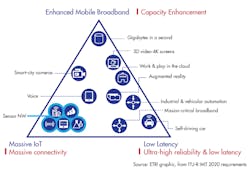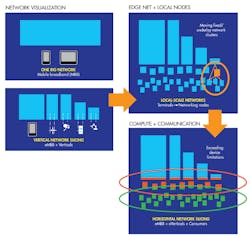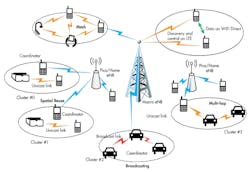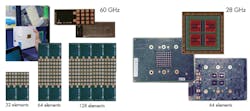High-Bands and Horizontal Slicing Challenge 5G
Many developers see 5G as a natural evolution beyond 4G in connectivity technology. But Intel is treating 5G differently from past systems, explained Dr. Geng Wu, Intel Fellow during his presentation at the recent 2017 Semi Pacific NW Forum. In addition to common goals of enhanced mobile bandwidth (EMBB), Wu sees unique 5G design issues dealing with massive machine-to-machine (M2M) connections, and ultra-reliable and low latency systems. The latter are captured in specifications for massive machine-type communications (mMTC) and ultra-reliable and low-latency communications (URLLC).
“In human communications, if you dial a wrong phone number, you correct it and move on,” notes Wu. “But machines could get stuck, which is why machine communications, artificial intelligence and the way devices work need to be different from before.” This is one reason why ultra-reliability will be even more important in 5G.
Further, low-latency in 5G will have to address the slowest link in the communication chain, namely, humans.
1. Three dimensions to 5G performance improvements with usage scenarios for 2020 and beyond. (Source: ETRI Graphic, from ITU-R IMT 2020 Requirements)
Wu’s observations are on track with those of the 3GPP global initiative for the 5G mobile broadband standard (Fig. 1). 5G will place equal emphasis on not just eMBB, but also on mMTC and URLLC. This is the goal although equipment vendors and operators will decide how these goals will be realized.
High-Band
To meet these three goals, 5G needs a mix of spectrum including high-band. Most of today’s smartphones use spectrum under 3 GHz, considered low- to mid-band spectrum. High-band spectrum refers to frequencies typically above 6 GHz. These are not used for mobile wireless service today. However, in the near future, high-band spectrum above 24 GHz, known as “millimeter wave,” will be available for use in mobile broadband (Fig. 2). Together with low- and mid-band spectrum, high-band frequencies will enable the wide range of unique 5G use cases and applications.
2. High-band spectrum. (Courtesy of CTIA)
High-band data will deliver more bytes than before, with spectrum blocks that are 200 MHz or larger. These larger blocks will enable operators to carry significantly more traffic in a single channel, at higher speeds, and in support of many more wireless devices.
The price for the high-band data will be an increase in infrastructure. Unlike smartphone technology, which reaches several miles, high-band spectrum only extends for 200 meters or (several city blocks). Thus, providers will need to build out thousands of small cells to benefit from the high-capacity, low latency and multiple device capabilities of 5G.
Horizontal Slicing
This last point is an important one to consumers. Most 5G devices will not be their smart phones but smart things, e.g., cars, trains, wearables, drones, etc., and even moving nodes.
Supporting such demanding user cases and rising computing demands will require network and device capability scaling. This will require resource slicing, both vertically and horizontally. What does that mean?
3. 5G technology transformation to “compute + communication” systems. (Courtesy of Intel)
In a given network slice, dedicated resources (such as those within virtualized servers, network BW, QoS, etc.) are guaranteed. Slices are isolated from each other, so an error or fault in one slice does not cause any effect on communication in other slices. A slice can be considered as a set of flows belonging to different end users, e.g., mobile clients of the wireless service. A slice supports flows of multiple end users, but at the same time, an end user can participate in multiple slices.
5G is based on end-to-end vertical (industry) and horizontal (system capacity) slicing. Vertical is already being done in 4G core networks. With 5G, slicing will be extended in the radio access network (RAN) and air interface. Horizontal slicing will be done with computation and communication resources to form virtual computation platforms for solving the network capacity scaling problem.
Slicing is an evolutionary flow. It allows designers to evolve networks and devices, notes Wu (Fig. 3). Network virtualization has led to local-scale networks and is soon will contribute to compute and communication systems in 5G.
4. Densification of moving network clusters. (Courtesy of Intel)
5G needs slicing to enable the densification of network clusters into ultra-dense networks and device-to-device communication, so that it can support the development of moving networks and massive machine communications (Fig. 4).
5G Modems and Antennas
Earlier this year, Intel announced its first global 5G modem. It will be used for initial 5G spectrum trials and deployments worldwide using a baseband chip that supports both sub-6 GHz and mmWave bands. Supporting ultra-wideband operation and enabling multi-gigabit throughput with ultra-low latency, the modem pairs both with Intel’s sub-6-GHz 5G RFIC and 28-GHz 5G RFIC to deliver a global reach across the key bands. The 5G modem pairs with Intel® XMM 3760 LTE modem for 4G/5G dual connectivity.
5. Intel modular antenna array (60 GHz/28 GHz) for base stations. (Courtesy of Intel)
The high-band spectrum (60 GHz to 28 GHz) needed for 5G antennas are challenging as they require larger surface areas and longer feed lines. That’s why Intel is also testing out various modular, 60/28-GHz, antenna-array configuration for base stations (Fig. 5).
Summary
The three common goals in 5G systems include EMBB, massive M2M connections, and URLLC systems. To achieve these goals, high-band-capable radio systems and horizontal slicing of applications, networks, and air interfaces will be needed.






